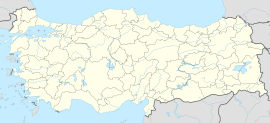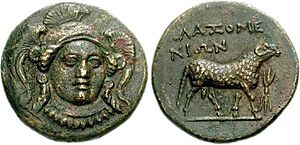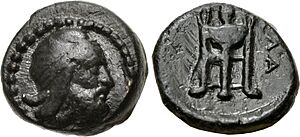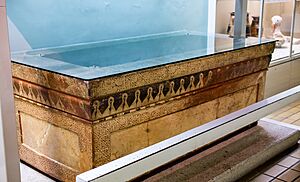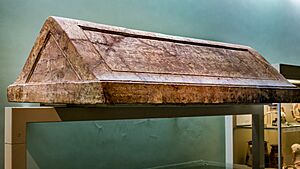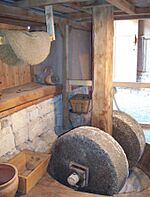Klazomenai facts for kids
|
Κλαζομεναί
|
|
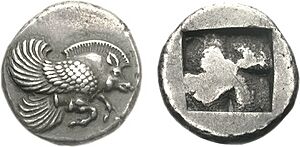
Coin from Klazomenai depicting a winged boar, 499 BC
|
|
| Alternative name | Clazomenae |
|---|---|
| Location | Urla, İzmir Province, Turkey |
| Region | Ionia |
| Coordinates | 38°21′29.4″N 26°46′3.3″E / 38.358167°N 26.767583°E |
| Type | Settlement |
Klazomenai (also called Clazomenae) was an important ancient city in a region called Ionia, which is now part of Turkey. It was one of 12 special cities that belonged to the Ionian League, a group of powerful Greek cities. Klazomenai was one of the very first cities to make its own silver coins! Today, you can find the ruins of this old city near the modern town of Urla, close to İzmir.
Contents
Where Was Klazomenai Located?
Klazomenai was found on the western coast of Anatolia, which is modern-day Turkey. It was about 32 kilometers (20 miles) west of İzmir, right on the southern coast of the Gulf of İzmir.
The city first stood on the mainland at a place called Limantepe. But around 400 BC, during a revolt against the Persians, the people moved their city. They rebuilt it on Karantina Island, just off the coast.
Later, a new town called Chyton was built on the mainland. These two places often had disagreements. However, Alexander the Great eventually built a causeway (a raised road) to connect Karantina Island to the mainland. You can still see parts of this old causeway today.
Klazomenai and Greek Mythology
A silver coin from Klazomenai shows the head of Apollo, who was the main god of the city. In Greek myths, swans were said to pull Apollo's chariot. He would fly south in it every year from his winter home.
Klazomenai was also home to many swans. The word klazo was thought to describe the sound these wild birds made. So, the swan on the city's coins was a symbol of Apollo and also a clever play on the city's name.
Klazomenai Through History
Klazomenai was not built until the Ionians arrived in Asia. Its first settlers mainly came from the cities of Phlius and Cleonae.
The city was attacked by the Lydian king Alyattes in the 6th century BC. During the 5th century BC, Klazomenai was under the control of the Athenians. But in the middle of the Peloponnesian War (412 BC), it tried to break free. After a short fight, it rejoined the Athenians and helped them fight off an attack from Lacedaemon.
In 387 BC, Klazomenai and other Asian cities were taken over by Persia. Even so, the city was still allowed to make its own coins.
Several famous thinkers came from Klazomenai:
- The philosopher Anaxagoras (around 510–428 BC) was born here.
- An earlier philosopher named Hermotimus of Clazomenae also came from Klazomenai.
- Herodotos of Klazomenai was the first person from the city to win an Olympic race. He won the boys' foot-race.
- Scopelian or Skopelianos, an ancient Greek teacher (sophist), was also from Klazomenai.
When the Romans took over, Klazomenai became part of the Roman province of Asia. The city was special because it did not have to pay taxes.
Klazomenai also became an early Christian center. Bishops from Klazomenai attended important church meetings, like the Council of Ephesus in 431 AD. Today, Klazomenai is no longer an active bishopric, but it is listed by the Catholic Church as a "titular see," which means it's a historical title.
Archaeological Discoveries
At the site of Limantepe, near an old harbor, archaeologists have found very important Bronze Age remains. One of the most interesting discoveries is many different ancient burial sites. These sites might have been used by different groups of people in the society.
Klazomenai was well-known for making and selling olive oil. It was also famous for its painted terracotta Klazomenian sarcophagi. These were large, decorated coffins, and they are some of the best examples of Ionian painting from the 6th century BC.
A huge painted terracotta sarcophagus and its lid were found near Klazomenai in the late 1800s. This ancient Greek artwork, from around 500 BC, shows scenes of battles, chariot racing, and hunting. It also has many geometric patterns. This sarcophagus, weighing about 2 tons, is now in the British Museum.
The city was also valued for its special kind of garum, which was a popular fish sauce.
Ancient Olive Oil Production
Archaeologists found an ancient olive oil workshop (called an işlik) in Klazomenai. It dates back to the 6th century BC. This is the only surviving example of a specific type of olive press from an ancient Greek city. It is at least 200 years older than the next oldest presses found in Greece!
This ancient olive press was rebuilt in 2004–2005 by a team from Ege University, a Turkish olive oil company, and a German building company. They used the clear remains of the millstone and three pits to guide them. The olive oil made with the reconstructed press was even a success in business! You can find this rebuilt olive oil press at the original mainland site of Klazomenai.
Financial Innovations
The people of Klazomenai were also pioneers in how they handled money. The famous philosopher Aristotle wrote about an event where Klazomenians used one commodity (like a product) to buy another.
Around 350 BC, the city needed more grain and was short on money. So, the city leaders asked citizens who had olive oil to lend it to the city. The city then used the value of this olive oil as a promise to get a loan. They hired ships and bought grain from other ports. This was a clever way to get what they needed when money was scarce.
See also
- List of ancient Greek cities
- Klazomenian vase painting
- Limantepe; the prehistoric site in Urla


